
Agrotis is a genus of moths of the family Noctuidae. The genus was erected by Ferdinand Ochsenheimer in 1816. A number of the species of this genus are extinct.

Agrotis ipsilon, the dark sword-grass, black cutworm, greasy cutworm, floodplain cutworm or ipsilon dart, is a small noctuid moth found worldwide. The moth gets its scientific name from black markings on its forewings shaped like the letter "Y" or the Greek letter upsilon. The larvae are known as "cutworms" because they cut plants and other crops. The larvae are serious agricultural pests and feed on nearly all varieties of vegetables and many important grains.
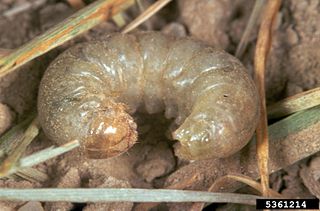
Agrotis orthogonia, the pale western cutworm, is a moth of the family Noctuidae. The species was first described by Herbert Knowles Morrison in 1876. It is found in North America, more specifically dry, semi-desert areas of western North America from southern Canada to California, ranging eastward nearly to the eastern edge of the Great Plains.

Abagrotis alternata, the greater red dart or mottled gray cutworm, is a moth of the family Noctuidae. The species was first described by Augustus Radcliffe Grote in 1865. It is found in eastern North America, from New Brunswick west across southern Canada to western Alberta, south to Arizona, New Mexico and the Gulf of Mexico.
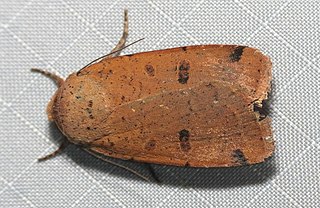
Abagrotis cupida, the Cupid dart or brown climbing cutworm, is a moth of the family Noctuidae. The species was first described by Augustus Radcliffe Grote in 1865. It is found in southern Canada and in the United States east of the Rocky Mountains.
Abagrotis trigona, the luteous dart, is a moth of the family Noctuidae. The species was first described by Smith in 1893. It is found in North America from western South Dakota and south-western Manitoba west across southern Saskatchewan and Alberta to Vancouver Island, south to the Mexican border. There is also a disjunct population in Ohio.
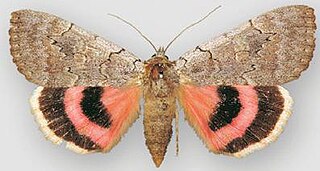
Catocala concumbens, the sleepy underwing or pink underwing, is a moth of the family Erebidae. The species was first described by Francis Walker in 1858. It is found in eastern North America, west across the southern half of the Prairie Provinces to eastern Alberta.
Agnorisma bugrai, the collard dart, is a moth of the family Noctuidae. The species was first described by Ahmet Ömer Koçak in 1983. It has a transcontinental distribution in North America, from central Canada and the northern United States, southward in the Rocky Mountains to Colorado.
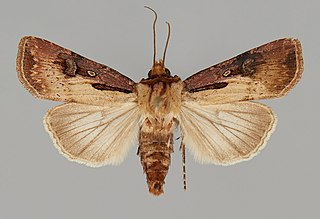
Agrotis obliqua is a moth of the family Noctuidae first described by Edgar Albert Smith in 1903. It is found in North America from Newfoundland to Vancouver Island, south to Colorado, Arizona and California.

Agrotis robustior is a moth of the family Noctuidae first described by Smith in 1899. It is found on the northern Great Plains of North America, the Prairie Provinces of Canada southward to South Dakota and Colorado.

Agrotis venerabilis, the dusky cutworm, is a moth of the family Noctuidae. The species was first described by Francis Walker in 1857. It is found from coast to coast from central Canada south to Mexico.

Agrotis ruta is a moth of the family Noctuidae first described by Eduard Friedrich Eversmann in 1851. It has a Holarctic distribution. In North America it has a northern distribution, occurring from Alaska and the Yukon Territory to Labrador, south to northern Manitoba and British Columbia, and in the Rocky Mountains to southern Alberta. Furthermore, it can be found in the northern Urals, Siberia, Mongolia, China and Japan.

Agrotis stigmosa is a moth of the family Noctuidae first described by Herbert Knowles Morrison in 1875. It is found in North America from New England and Quebec west to Colorado and eastern Alberta. It is listed as a species of special concern in the US state of Connecticut.

Agrotis vancouverensis, the Vancouver dart, is a moth of the family Noctuidae. The species was first described by Augustus Radcliffe Grote in 1873. It is found in the Pacific Northwest of North America and is common west of the Cascade Mountains.

Agrotis volubilis, the voluble dart moth, is a moth of the family Noctuidae. The species was first described by Leon F. Harvey in 1874. It is found in North America, from Newfoundland to British Columbia in Canada and in the United States from Maine to Florida and west to the West Coast.
Autographa flagellum, the silver whip, is a moth of the family Noctuidae. The species was first described by Francis Walker in 1858. It is found in North America from Newfoundland west across southern Canada to south-eastern British Columbia, south in the east to Maine, Michigan and Wisconsin. There are isolated reports from further south.

Protolampra brunneicollis, the brown-collared dart, is a moth of the family Noctuidae. The species was first described by Augustus Radcliffe Grote in 1864. It is found in eastern North America from New Brunswick to Alberta in southern Canada, and in the United States from Maine to North Carolina and Tennessee west to Mississippi, north to Minnesota, with scattered records in the west from North Dakota, South Dakota and Montana.
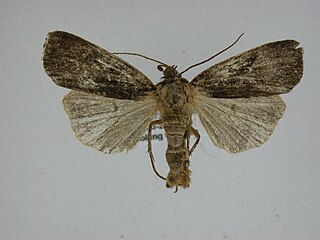
Pseudohermonassa bicarnea, the pink-spotted dart, is a moth of the family Noctuidae. The species was first described by Achille Guenée in 1852. It is found in eastern North America, and as far west as south-central Saskatchewan and central North Dakota, south to western North Carolina. It has recently been recorded from Tennessee.
Euxoa declarata, the clear dart, is a moth of the family Noctuidae. The species was first described by Francis Walker in 1865. It is found in Canada in Ontario, Quebec, New Brunswick, Nova Scotia, Prince Edward Island, British Columbia, Alberta, Saskatchewan, Yukon and Manitoba. It is found as far west as central Alaska. In the United States it is also found to Minnesota and North Carolina in the east and Arizona, New Mexico and California in the west.
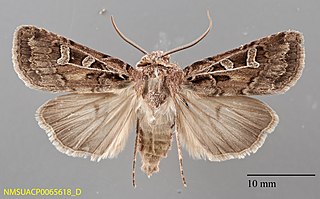
Euxoa divergens, the divergent dart, is a moth of the family Noctuidae. The species was first described by Francis Walker in 1857. It is found in North America from Newfoundland to Alaska, south to New York and Michigan in the east, and in the mountains of the west, south to New Mexico, Arizona and California.
















